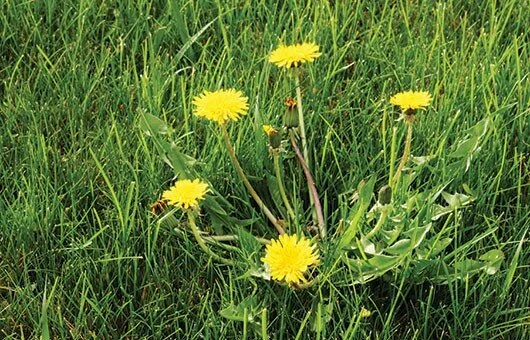Warm spring breezes, longer days, and blossoming gardens and trees are all welcome signs of spring and the summer to come. Flowers and turfgrass are not the only plants that look forward to warmer weather. Crabgrass and broadleaf weeds are invaders that love spring as well and, if left to their own devices, will take over your entire lawn.
Not The Lawn You’re Looking For
Mixed in among your intended grass is a heartier, uglier, and more aggressive type of turf: crabgrass. Crabgrass is a thick and gangly turf that can spread quickly. Crabgrass seeds can lay dormant for several years before emerging. Once conditions are right and this weed rears its head, crabgrass can be very hard to beat. As the summer heat wears on, crabgrass thrives while your intended turf struggles, making for an unfavorable balance of power within your lawn.
Broadleaf (non-grass) weeds such as dandelions, chickweed, and thistles also flourish in hostile summer conditions. Unlike crabgrass, these weeds tend to stick out visually. Like crabgrass, they love to edge out your turf for space and resources.
Treatment and Timing
Proactive treatment of crabgrass and broadleaf weeds is crucial to minimizing their effects. For crabgrass, a pre-emergent treatment creates a barrier on the soil’s surface that prevents crabgrass seeds from germinating. When treatments are properly applied, most of your crabgrass issues can be prevented before becoming apparent. Broadleaf weeds are generally treated once they have already appeared. For maximum control, broadleaf treatments should happen while the weeds are in their vigorous spring growth cycle. Ideal timing for both crabgrass and broadleaf weeds varies, based on location and weather conditions. Your local lawn care professionals will have a detailed sense of when to treat, based on current conditions.
Take Control with Good Cultural Practices!
The best way to attack weeds in your lawn is to make your lawn as strong as possible. Weeds cannot make inroads unless they are given an opportunity. By keeping your lawn well fed and watered, you foster healthy turf that is hostile to weeds. Mowing properly (removing no more than one-third of the blade at a time) decreases direct sunlight on the soil, reducing soil temperatures and discouraging weed growth. In fact, studies have shown that good mowing habits can reduce weeds by 80%!

